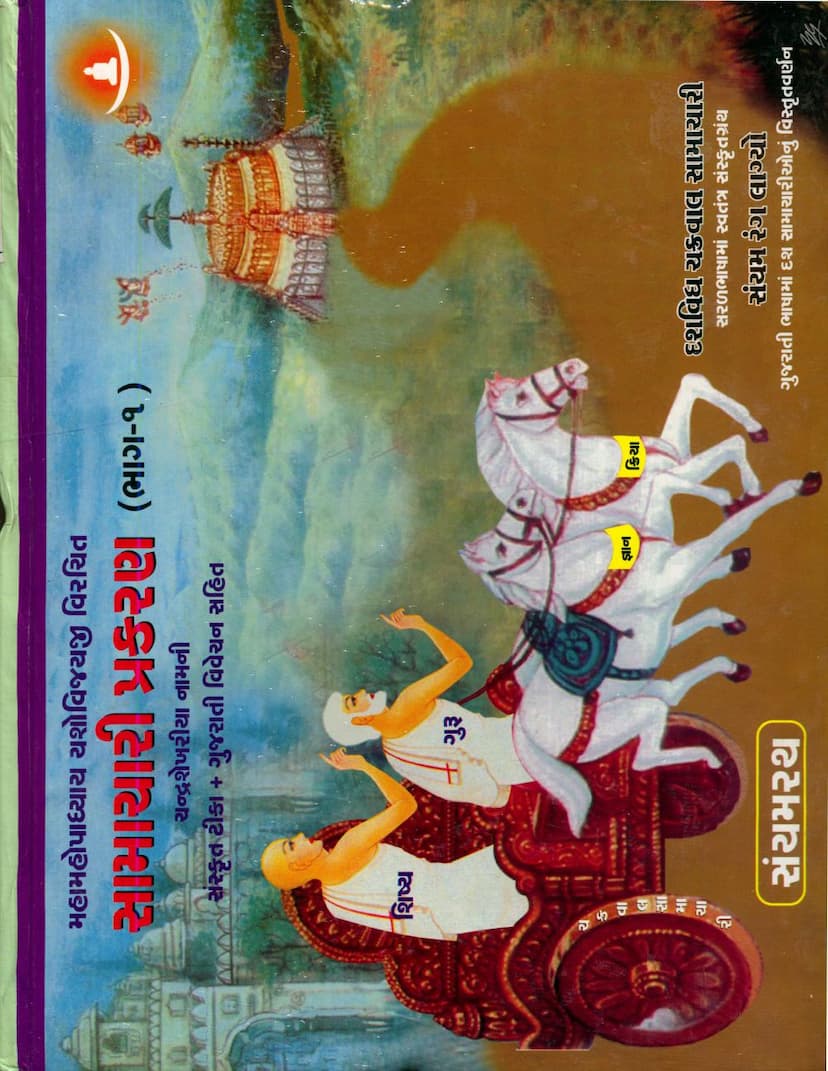Samachari Prakaran Part 01
Added to library: September 2, 2025

Summary
Here's a comprehensive summary of the Jain text "Samachari Prakaran Part 01," based on the provided pages, highlighting the key aspects of its content and structure:
Book Title: Samachari Prakaran Part 01 Author(s): Yashovijay Maharaj (Original work), Chandrashekharvijay (Commentary and Gujarati translation) Publisher: Kamal Prakashan Trust
Overall Purpose: The book "Samachari Prakaran Part 01" is presented as a guide for ascetics (sadhus and sadhvis) in their daily conduct and spiritual discipline. It aims to elucidate the essential principles of conduct, known as "Samachari," for achieving higher spiritual progress. The text emphasizes the importance of these practices as the foundation of an ascetic's life and provides detailed explanations suitable for individuals at various stages of spiritual development.
Structure and Content: The text is a commentary on the original "Samachari Prakaran" by Mahamahopadhyaya Yashovijay Maharaj. The commentary, titled "Chandrashekheriya Tika," along with a Gujarati exposition, is provided by Pandit Chandrashekharvijayji. The book is structured to cater to different levels of understanding among ascetics:
-
For Ascetics with Intense Kshayopasham (Intellectual Capacity) and Knowledge of Nyaya Texts: These ascetics are advised to read Yashovijay Maharaj's commentary along with the "Chandrashekheriya Tika." The commentary is designed to clarify the complex philosophical points and reveal the underlying secrets of the original text. It achieves this by posing questions that the original text answers, thereby explaining the context and purpose behind each verse or statement.
-
For Ascetics with Medium Kshayopasham and General Sanskrit Knowledge (but not advanced Nyaya study): For these individuals, the book presents a separate, independent commentary called "Dashavidh Chakrawal Samachari." This section is simplified, avoiding complex Nyaya discussions, and focuses on explaining the ten types of Samachari in a straightforward manner. It is intended to be accessible and provide clear explanations.
-
For Novice Ascetics, Seekers (Mumukshus), and those with Limited Sanskrit Knowledge: A third section, titled "Sanyam Rang Lagyo," offers a detailed explanation of the ten Samacharis in Gujarati. This section is specifically designed for those with limited exposure to scriptures or Sanskrit, making the teachings easily understandable.
Key Themes and Concepts Discussed (as per the provided Preface and excerpts):
- The Ten Samacharis: The book's core focus is on the "Ten Samacharis" (Das Samachari), which are fundamental practices for ascetics. These are elaborated upon extensively. The included excerpts specifically mention and discuss "Ichhakara Samachari" and "Michhakara Samachari" in great detail.
- Importance of Conduct (Achar): The text stresses that proper conduct is the bedrock of ascetic life and is crucial for attaining spiritual liberation.
- Commentary and Elucidation: The "Chandrashekheriya Tika" aims to unlock the deeper meanings and secrets within Yashovijayji's original work, which are considered difficult to grasp from the original texts alone.
- Naya Vichaar (Different Perspectives): The commentary delves into various philosophical viewpoints (Nayas) such as Sangrahanaya, Vyavaharanaya, Rujusutranaya, Shabdanaya, Samabhirudha, Evam Bhuta, and Naigamanaya, as they relate to the understanding and practice of Samachari. This highlights the sophisticated philosophical framework within which Jain asceticism operates.
- Detailed Analysis of Ichhakara and Michhakara: Significant portions of the provided text are dedicated to explaining "Ichhakara" (acting with willing consent or request) and "Michhakara" (expressing remorse for wrongdoings or mistakes). These discussions include:
- Definition and Purpose: Explaining what Ichhakara and Michhakara truly mean in the context of ascetic conduct.
- Conditions for Practice: Outlining when and how these practices should be performed.
- Consequences of Non-Adherence: Detailing the spiritual drawbacks of failing to follow these rules.
- Benefits: Highlighting the spiritual merits and karmic purification derived from their correct observance.
- The Role of Intention (Bhav): Emphasizing that the inner disposition and intention behind the action are as crucial, if not more so, than the outward action itself.
- Nuances of Application: Discussing how these principles apply differently based on the spiritual stature of the individuals involved (e.g., Gurus and disciples, senior and junior ascetics).
- Scriptural Basis: Citing verses from authoritative Jain scriptures like the Avashyak Niryukti and Panchashaka to support the explanations.
- Wisdom of the Gurus: The text frequently refers to the interpretations and insights of past enlightened masters like Acharya Bhadrabahuswami, Acharya Haribhadrasuri, and Acharya Yashovijayji, showcasing a lineage of profound spiritual knowledge.
- Importance of Right Understanding and Application: The commentary stresses the need for correct understanding and diligent practice of these Samacharis, highlighting that mere outward observance without the right inner disposition (Bhav) is insufficient for true spiritual progress.
- The "Tathakar" Samachari: The text also begins to delve into the "Tathakar" Samachari, emphasizing the importance of sincere agreement and affirmation in response to a Guru's teachings, especially from those who are spiritually advanced or respected. The commentary explores the nuances of when and how this affirmation is appropriate and its spiritual significance.
- The "Aavashyakí" and "Nishīdhī" Samacharis: These are discussed in detail, focusing on the specific contexts and conditions under which they are to be performed. "Aavashyakí" relates to the necessary actions before embarking on a journey or entering a sacred space, often involving a declaration of intent. "Nishīdhī" is explored in the context of renouncing sinful actions and maintaining purity, especially when in the presence of elders or in sacred environments. The commentary clarifies the subtle distinctions and proper application of these practices.
Commentary's Contribution: The "Chandrashekheriya Tika" and Gujarati exposition are crucial for making the profound teachings of Mahamahopadhyaya Yashovijayji accessible. It clarifies difficult passages, explains the underlying intent, and provides context, making the study of these practices more beneficial for the spiritual aspirant.
Overall Impression: The provided pages offer a glimpse into a deeply philosophical and practical text on Jain monastic discipline. The detailed analysis of each Samachari, particularly Ichhakara and Michhakara, showcases the meticulous attention to detail and the profound ethical and spiritual insights within Jainism. The commentary serves as a vital tool for understanding and internalizing these ancient teachings for contemporary spiritual practice.